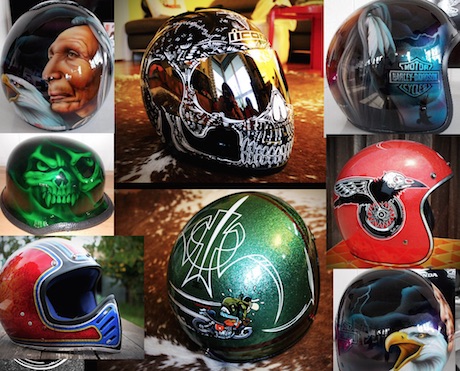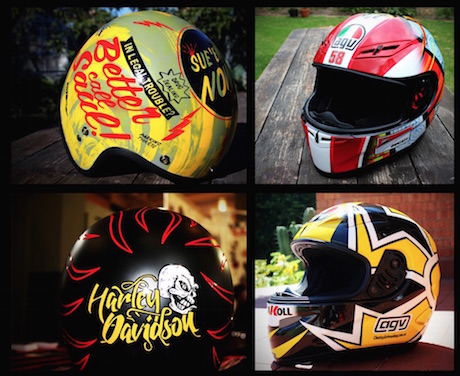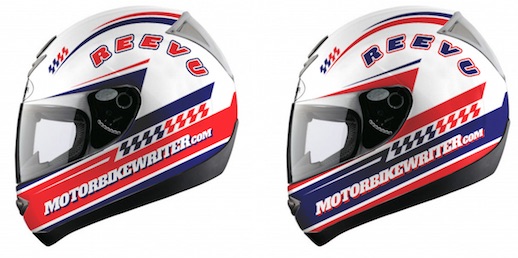A lot of riders have painted motorcycle helmets with spray gun to express their individuality, but are they legal?
Given the police propensity to fine over minor helmet issues and after a reader asked this very question, we thought it prudent to check the legality.
We approached helmet law experts, helmet painters, and transport departments and police in several states for their views.
We have also updated this article to include the fact that European-approved helmets (UNECE22.05) are now permitted to be sold and worn in Australia.
You might also like to read this article on helmet laws as they currently stand.
COPS AND BUREAUCRATS
The Victorian police who have a record of fining riders for wearing cameras on their helmets or having tinted “non-compliant” visors, say they have no records of anyone being fined for having a painted helmet or stickers helmet and that “so long as the rider checks with the manufacturer, uses the right paint and keeps the compliance sticker intact, it’s ok”.
That view was reflected by police in WA and NSW.
However, Queensland Police, who seem to have no issue with tinted visors or cameras on your helmet, do say painting a helmet would cause it to be non-compliant with AS 1698.
“As such, it would not be considered an approved motorcycle helmet under the Road Rules, therefore earning eligibility for a fine for the user,” they say.
They point to Section 270 of the Transport Operations (Road Use Management – Road Rules) Regulation 2009, which requires that riders and passengers on motorcycles must wear an approved motorbike helmet securely fitted and fastened. Subsection (3) defines an approved motorcycle helmet as a helmet that complies with AS (Australian Standard) 1698 or AS/NZS 1698 (‘Protective Helmets for Vehicle Users’). This standard requires, among other things, requirements for testing, marking, and advice/instructions to users of motorcycle helmets. The required advice/instructions include:
- A direction to the user to make no modifications to the helmet;
- A warning that petroleum, petroleum products, cleaning agents, paint, adhesives, etc. may damage the helmet and make it ineffective; and
- A requirement that there be, in any brochure with or label on, the helmet, the following wording: “The protection of this helmet may be severely reduced by the application of paint, adhesive stickers or transfers, cleaning or other solvents. Use only materials recommended by the helmet manufacturer.”
- If a helmet were to be modified by painting, etcetera, the user would be required to provide evidence that the shell material is not affected by contact with hydrocarbons, cleaning fluids, paints, transfers or other extraneous additions.
However, helmet law reform advocate Wayne Carruthers says the QPS claim that painting a helmet renders a helmet non-compliant and that the onus of proof is on the defendant to provide evidence that the shell material is not affected is a reversal of the onus of proof.
“It is the prosecution which is required to prove painting has rendered the helmet non-compliant,” he says.
He also points out that the Queensland Road Rules (unlike other states) precisely specifies in Part 1 Division 2, Section 5, Clause 2 that compliance applies only at the point of sale for Australian Standard items.
“(2) If this regulation requires a person to fit or use a thing that complies with a standard mentioned in subsection (1), the person complies with the requirement if, when the thing was manufactured, the thing complied with the standard in force under the designation at that time.”
Meanwhile, the NSW Centre for Road Safety GM Bernard Carlon confirmed that painting a helmet can do “unseen damage to its structure, which is why the Australian Standard prohibits painting a helmet unless you use paint approved by the manufacturer”.
“Using paint that is not approved by the manufacturer can affect the helmet’s ability to protect your head, and therefore would not comply with the Australian Standard. Not complying with the standard means the helmet would be illegal to use on NSW roads or road related areas,” he says.
Again Wayne disagrees re the claim that paint must be approved by a manufacturer. “There is no such statement in AS1698 regarding paint,” he says.
While no authority could say whether anyone had been fined for having a painted or stickered helmet, they also pointed out that they only collect infringement statistics for offences where riders are not wearing an approved helmet. So there still could have been riders fined for painted or stickered helmets. We simply don’t know.
Wayne points out that there is only one helmet offence which is wearing no helmet.
“In fact, there are no national statistics on helmet offences as the ABS does not collect statistics for motorcycle helmets while they do collect them for bicycle helmets because motorcycle helmet infringements are considered so rare,” he says.
HELMET PAINTERS
Helmet painters who use automotive spray guns or paint by hand were obviously of the view that it is legal.
However, one warned “I would just like to emphasise that this is to the best of our knowledge and I would strongly advise researching this further”.
Another helmet spray painter says he has been asked the question of legality “many times”.
“All I can say is that 99% of helmets sold are already painted from the factory, either in say black or white solid colours or transfers designs with clear coats sprayed over the top,” says the painter who asked not to be named “for legal reasons”.
“In my opinion, I can’t see any safety hazard to re-coat the helmet with more paint over the top of the factory painted surface that is already there.
“Newly re-painted and airbrushed helmets get passed by ANDRA inspections (drag racing), kart racing inspections and Formula 1 and 2 racing, to pass these rules and safety regulation set by these organisations.”
He says the only times it is unsafe to paint a helmet is:
- if the helmet is damaged;
- if you sand through the painted surface and into the plastic or fibreglass, therefore weakening the surface;
- if the solvents of new paint soften the plastic surface of a helmet; and
- if the lining and other components of the helmets are removed, unless designed to do so.
“I have painted all types of helmets over the last 30+ years, but don’t take my word as gospel,” he says.
Checkout this article on choosing the best HVLP spray gun.
HELMET LAW EXPERTS
For the “gospel truth” we turned to Australian Motorcycle Council Helmets Committee Chair Guy Stanford. There would be few people in the nation better versed in the arcane helmet rules than Guy.
He says there is no specific offence that relates to painting, but suggests you leave the sticker on the helmet and don’t paint over it.
“Road rules rely entirely on the sticker, so leave that alone,” he advises.
“Really, you might as well ask if it’s all right to swear at god. Lots of opinions about it. No accurate answer exists.”
Helmet law reform advocate Wayne Carruthers says the Northern Territory banned painted helmets in the 1970s because some spray paints were affecting the outer shells.

“As far as I am aware it was only the NT who properly wrote it into regulations,” he says. “These precise definitions were lost when the NT rewrote the road rules up there to directly make the Australian Road Rules law.”
He says there are no rules on painting/stickers for Australian-approved helmets (AS1698), only an advisory notes on the care of your helmet.
Similarly, he says the UNECE 22.05 rules also do not have clauses about stickers/painting.
MANUFACTURERS
If you check out the tags and labels that come with your new motorcycle helmet you’ll probably find a warning label that mentions painting your helmet or even applying stickers.
Guy says painting helmets is generally not advised by manufacturers.
“Solvents in paint can affect the ABS material of some helmets, particularly older helmets with the older ABS plastic formulation and no clearcoat to protect it,” he says.
“Fibreglass is usually OK, as long as the clearcoat layer is sound.
“If the clearcoat is damaged, there’s a risk of problems, like softening the shell due to solvent leakage into the shell material.
“In any case, it means using minimal solvents and minimal paint; like airbrush paints, carefully applied, rather than drenching with rattle cans of bumper bar spray.”
CONCLUSION?
Motorcycle and cars racers have had heavily painted and stickered helmets for years, yet the racing authorities find it poses no risk to the integrity or safety of the helmet.
Modern painted race helmets are often not painted at all but stickered with a plastic covering like our MotorBikeWriter helmets.
While there is still some interstate and inter-authority confusion over the painting and stickering issue, our helmet law experts insist it is legal to have a camera mounted on your helmet, yet that doesn’t stop police in NSW and Victoria from issuing fines.
So it may all come down to the officer and his interpretation and knowledge of the laws, plus how much he wants to harass a rider.
Sorry we can’t be more black and white, but legal issues are rarely black and white – more 50 shades of grey! Wear at your own risk and remember that what might be legal in one state might be considered illegal in another.
It just goes to show what a sham our helmet laws are and why they need to be clarified quickly before more innocent riders are fined.




